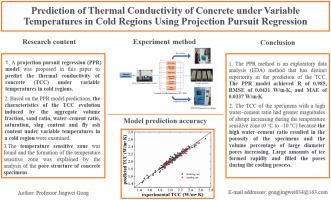Cold Regions Science and Technology ( IF 3.8 ) Pub Date : 2022-07-26 , DOI: 10.1016/j.coldregions.2022.103642 Jingwei Gong , Runxin Zheng , Can Qin , Rui Chen , Guoju Cao

|
A projection pursuit regression (PPR) model was proposed in this paper to predict the thermal conductivity of concrete (TCC) under variable temperatures in cold regions. The PPR model was established based on experimental data obtained from a single–factor experiment. Unlike the conventional PPR model that selected a random form from an empirical distribution function to describe the ridge functions in advance, the PPR model in this paper can directly apply numerical functions to describe the ridge functions obtained by projection. The comparison study indicated that, for the TCC prediction, the PPR model (R = 0.985) outperformed trained model based on Back–propagation (BP) neural network (R = 0.974). The PPR model simulation results demonstrated that the aggregate volume fraction, sand rate, saturation, water–cement ratio, fly ash content, and slag content all had impacts on the TCC under variable temperatures in cold regions. Especially, in temperature-sensitive zone (0 °C to −10 °C), it was found that the TCC of specimens with high water–cement ratio and high saturation degree increase abruptly but other factors did not cause the similar abrupt change of the TCC during the same temperature range. The correlation between the water-cement ratio and temperature–sensitive zone was explained after an in–depth study of the concrete pore structure.
中文翻译:

基于投影追踪回归的寒区变温下混凝土导热系数预测
本文提出了一种投影追踪回归(PPR)模型来预测寒冷地区变温下混凝土的导热系数(TCC)。PPR模型是基于从单因素实验获得的实验数据建立的。与传统的 PPR 模型预先从经验分布函数中选择随机形式来描述脊函数不同,本文的 PPR 模型可以直接应用数值函数来描述通过投影得到的脊函数。比较研究表明,对于 TCC 预测,PPR 模型 ( R = 0.985) 优于基于反向传播 (BP) 神经网络 ( R = 0.974)。PPR模型模拟结果表明,冷区变温条件下骨料体积分数、砂率、饱和度、水灰比、粉煤灰含量和炉渣含量均对TCC产生影响。特别是在温度敏感区(0 ℃~-10 ℃),发现高水灰比和高饱和度试件的TCC急剧增加,但其他因素并未引起类似的突变。 TCC 在相同的温度范围内。在深入研究混凝土孔隙结构后,解释了水灰比与温度敏感区之间的相关性。










































 京公网安备 11010802027423号
京公网安备 11010802027423号